A very detailed route description of a well known accident black spot, which will now be included in the new ‘Walkers Edition’ of the Wainwright guides.
Clive Hutchby was near to completion of revising book 6 of the Wainwright guides, when he mentioned to me about including the “other” Barf route into the ‘Walkers Edition’ of the North Western Fells. Because I had recently detailed Wainwright’s “direct ascent“ on this website, Clive asked me to compare the two routes with regard to terrain and difficulty. Wainwright stated that his route was: “Not a walk. A very stiff scramble, suitable only for people overflowing with animal strength and vigour”, however, this second route, which doesn’t stray too far from Wainwright’s, is slightly easier, and merits inclusion in the guide.
Within the photo descriptions, the main features of this route are placed in quotations, which have mostly been taken from page: Barf 6 in the North Western Fells guide.
GPX Route: Download
PDF Map: Download
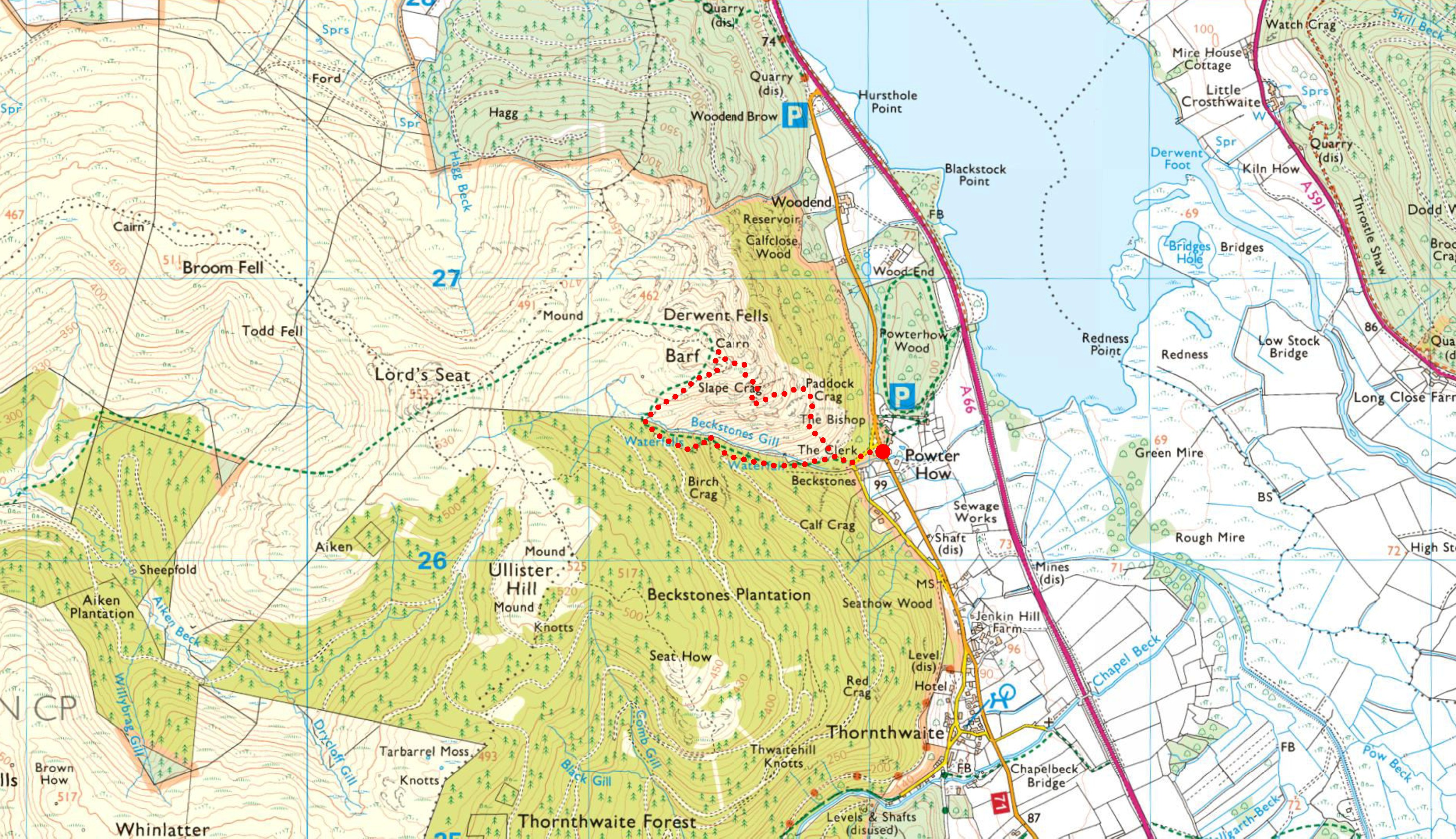
Powter How > The Clerk > The Bishop > Slape Crag > Barf > Beckstones Gill > Powter How
 Parking area opposite Swan House at Powter How
Parking area opposite Swan House at Powter How
A parking area, with enough room for 3 or 4 cars, and a bus stop, are conveniently situated at the base of Barf; the X5 Workington bus being only a short ride from Keswick town centre.
 The south-east ridge of Barf from Powter How
The south-east ridge of Barf from Powter How
To the left of centre in the picture above, the well known figure of ‘The Bishop’ stands on the south-east ridge of Barf. This whitewashed rock tower is clearly visible when travelling along the A66 between Keswick and Cockermouth.
In 1783, the newly appointed Bishop of Derry, was travelling along the road from Keswick to Cockermouth and he decided to spend the night at The Swan Inn. The Bishop, after enjoying several drinks, took a wager with the locals that he could ride his pack pony to the top of Barf. The pony struggled up the dangerously steep scree slope until it reached a large rock pillar, where it stumbled and fell. Both the horse and the Bishop were killed in the fall, and if you wish to believe local legend, they were buried at the foot of the slope beside another rock, now known as ‘The Clerk’. The landlord of The Swan Inn paid five shillings plus a quart of ale for the two rocks to be whitewashed; a tradition continued to this day.
Sadly, the story, although imaginative, forgets that the Bishop of Derry of the time died 20 years later in Italy.
“A unique feature that catches the eye from miles distant is the upstanding pinnacle long known as the Bishop of Barf, a venerable figure whose spotless vestments result from regular applications of whitewash. This is a task not lightly to be undertaken, for the stiff climb to the Bishop’s pulpit up shifting scree is a bad enough scramble without the grave added responsibility of balancing a bucket that must not be spilled. But the job must be done from time to time. Until recently the whitewash was applied by volunteers from the little community centred on the Swan Hotel directly below, but now the hotel has been turned into flats and the job has been taken over by the Keswick Mountain Rescue Team.” Barf 2
AW (updated by CJ)
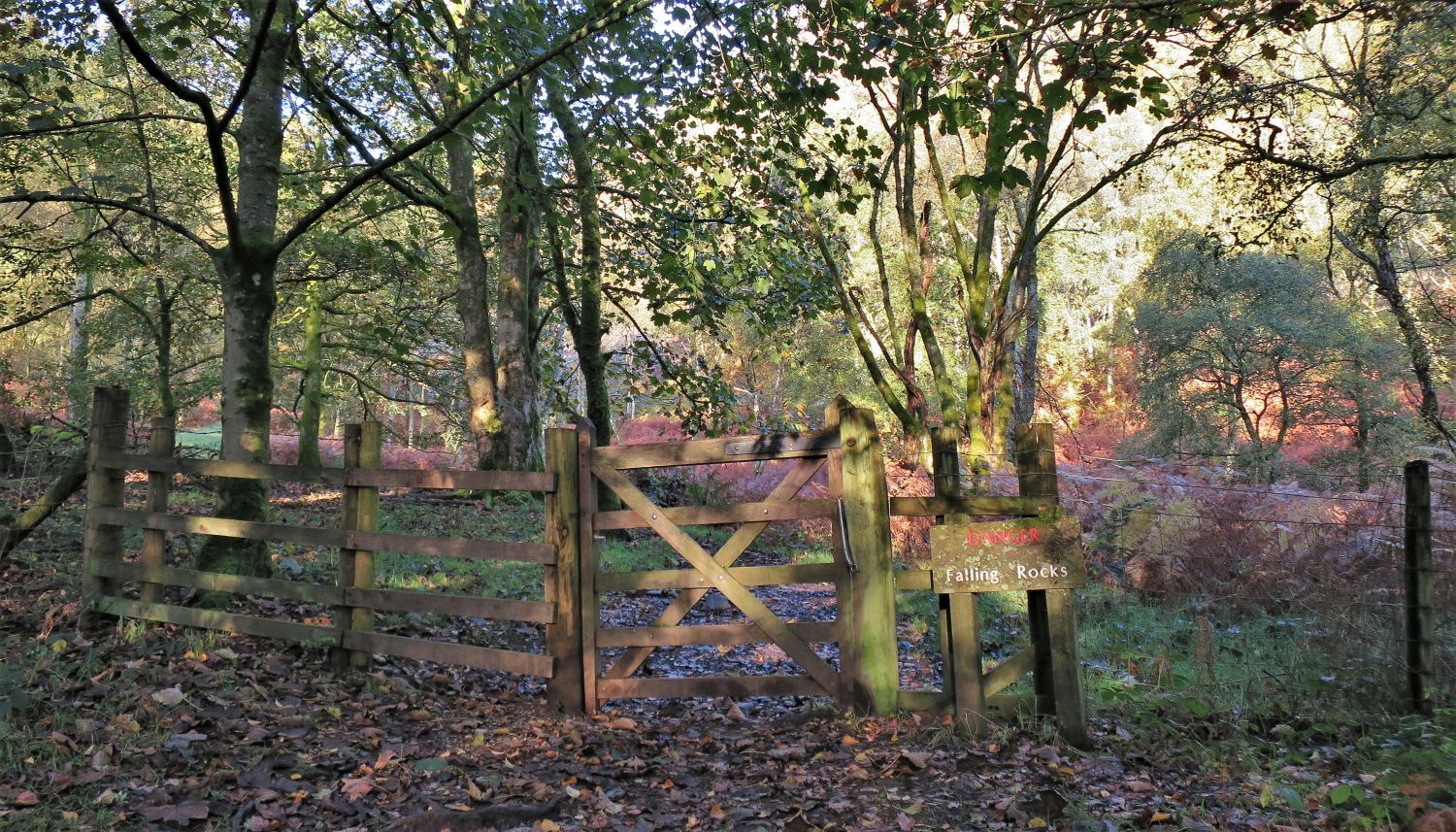 Gate at Beckstones
Gate at Beckstones
This gate was illustrated as being a “kissing gate” in the first and second editions of the Wainwright guides, but since my last visit, August 2016, it has changed. Even though only a small change, it is an example as to why the guides need to be revised on a regular basis.
 “The Clerk” at the base of Barf
“The Clerk” at the base of Barf
“Look out for the Clerk, an insignificant figure beside the path, almost hidden amongst trees at the foot of the slope.” Barf 6
“In comparison with the commanding figure of the Bishop, the Clerk is a poor drooping individual who attracts little attention to himself. He stands beside the path at the foot of the slope. He too wears white vestments, which are repainted from time to time by the Keswick Mountain Rescue Team.” Barf 5
AW
 The ascent of the “wide scree slope”
The ascent of the “wide scree slope”
Well here we go; there’s no easy zig-zag path at the start of this route, so it’s straight up!
“This wide scree slope, although not dangerous, is arduous to ascend, the feet often slipping down two steps for every step up…” Barf 6
AW
 Skiddaw range over Swan House
Skiddaw range over Swan House
 Looking across to Beckstones Plantation
Looking across to Beckstones Plantation
 Frankie on the “wide scree slope”
Frankie on the “wide scree slope”
 Approaching “The Bishop”
Approaching “The Bishop”
 Book Six
Book Six
The North Western Fells
Barf 5
“The Bishop – rear view, looking down to the Swan Hotel”
“A visit to the Bishop discloses that, behind the spotless raiment he displays to the road below, his rear quarters are equally brightly annointed. The monolith is not as tall as may be imagined: seven feet on the shortest side. Nevertheless it is to his credit that he has maintained his stately presence, for all around is the debris of shattered and eroded slate; the Bishop is slate, too, although obviously cast in a sterner mould. The time will come, however, when a collapsing pulpit will topple him down the screes.” Barf 5
AW
 Bishop’s Rock (date of postcard unknown)
Bishop’s Rock (date of postcard unknown)
“Bishop’s Rock” having its annual coat of white-wash, a Cumberland custom carried out by the Landlord of the “Swan” Thornthwaite, for many years.
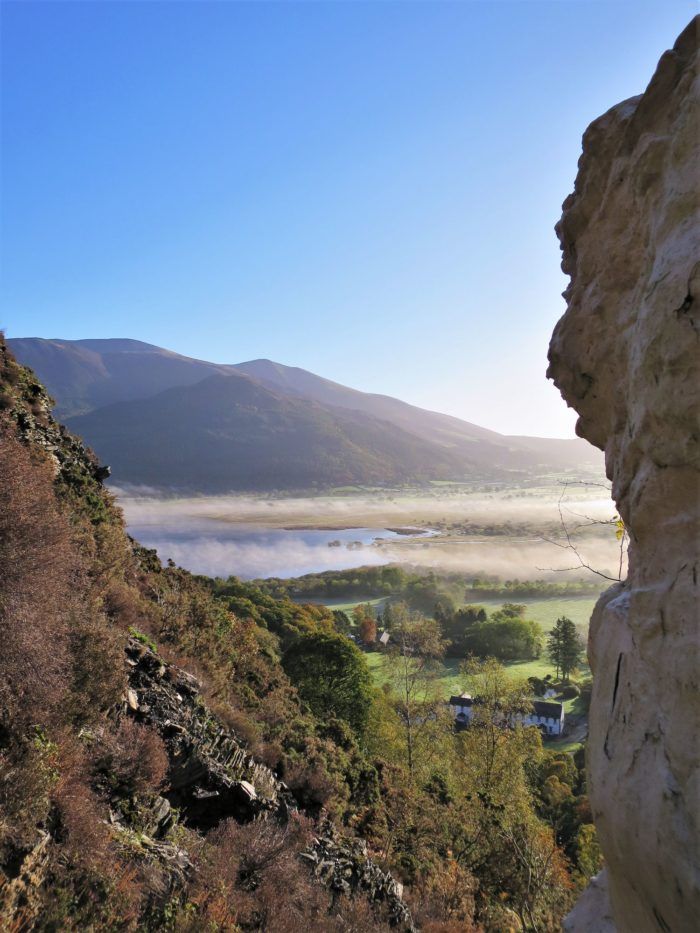 Looking down to Swan House from “The Bishop”
Looking down to Swan House from “The Bishop”
 The “scree gully”
The “scree gully”
Beyond the Bishop is the “scree gully” that Wainwright mentioned, however, this is where our route deviates to take a slightly easier course.
 The path leaving “The Bishop”
The path leaving “The Bishop”
To the right of the “scree gully”, a narrow path through the heather heads upwards towards the eastern flank of Barf; as usual, Frankie shows the way.
 Looking down the steep south-east ridge from above “The Bishop”
Looking down the steep south-east ridge from above “The Bishop”
 Looking across to the “walls” of the “scree gully”
Looking across to the “walls” of the “scree gully”
To the right in the picture, you can see how steep the path is that ascends the “scree gully”. Wainwright describes the gully and its walls wonderfully:
“The scree gully is unpleasant. Its walls of rotten rock cannot be trusted for handholds and fall apart at a touch. The ’tiles’ here pull out like drawers.” Barf 6
AW
 The Skiddaw range over Bassenthwaite Lake
The Skiddaw range over Bassenthwaite Lake
The path now reaches the top treeline and continues traversing the eastern flank of Barf.
 Wind shelter on the eastern slope of Barf
Wind shelter on the eastern slope of Barf
The path continues traversing along the eastern flank, but before following a path to the left, which heads back to the south-east ridge, continue a little further to this wind shelter, where you’ll be rewarded with a great ‘seat with a view’.
 Approaching the “solitary rowan” with Slape Crag behind
Approaching the “solitary rowan” with Slape Crag behind
The path now snakes its way back onto the south-east ridge where it meets Wainwright’s route above the “scree gully”.
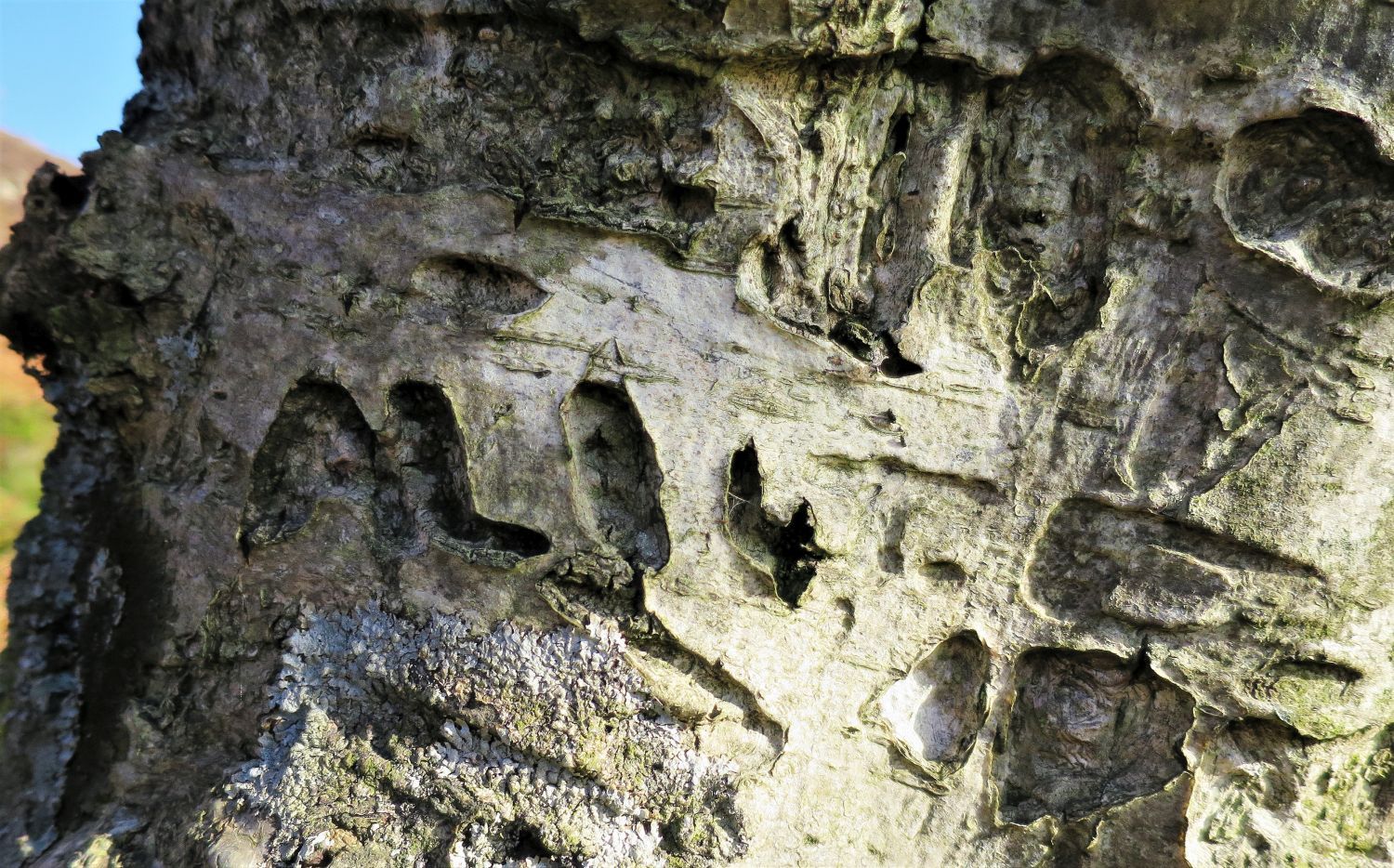 Carvings from “earlier visitors”
Carvings from “earlier visitors”
“By the time the rowan tree is reached the feeling that one is pioneering a new ascent, treading where no man has trodden before, is very strong, and consequently it is mortifying to find the slender trunk of the tree elaborately carved with the initials of a number of earlier visitors.” Barf 6
AW
This is one of those special Alfred Wainwright moments that you never forget. Not because you are in agreement, but knowing you stood exactly where he stood when he had these thoughts.
 Slape Crag from the “solitary rowan”
Slape Crag from the “solitary rowan”
We are not on Wainwright’s route for long, and just beyond the “solitary rowan” an easier path heads towards the small tree to the right in the picture. This path avoids the ‘second gully’ which is beyond the larger tree left of centre; surprisingly, Alfred Wainwright doesn’t mention this ‘second gully’ on page: Barf 6.
 Beckstones Plantation from the bield on the south-east ridge
Beckstones Plantation from the bield on the south-east ridge
 The path leading to the top of the ‘second gully’
The path leading to the top of the ‘second gully’
From the bield, the path, although now not so well defined, heads to the top of the ‘second gully’; Frankie shows the way, of course.
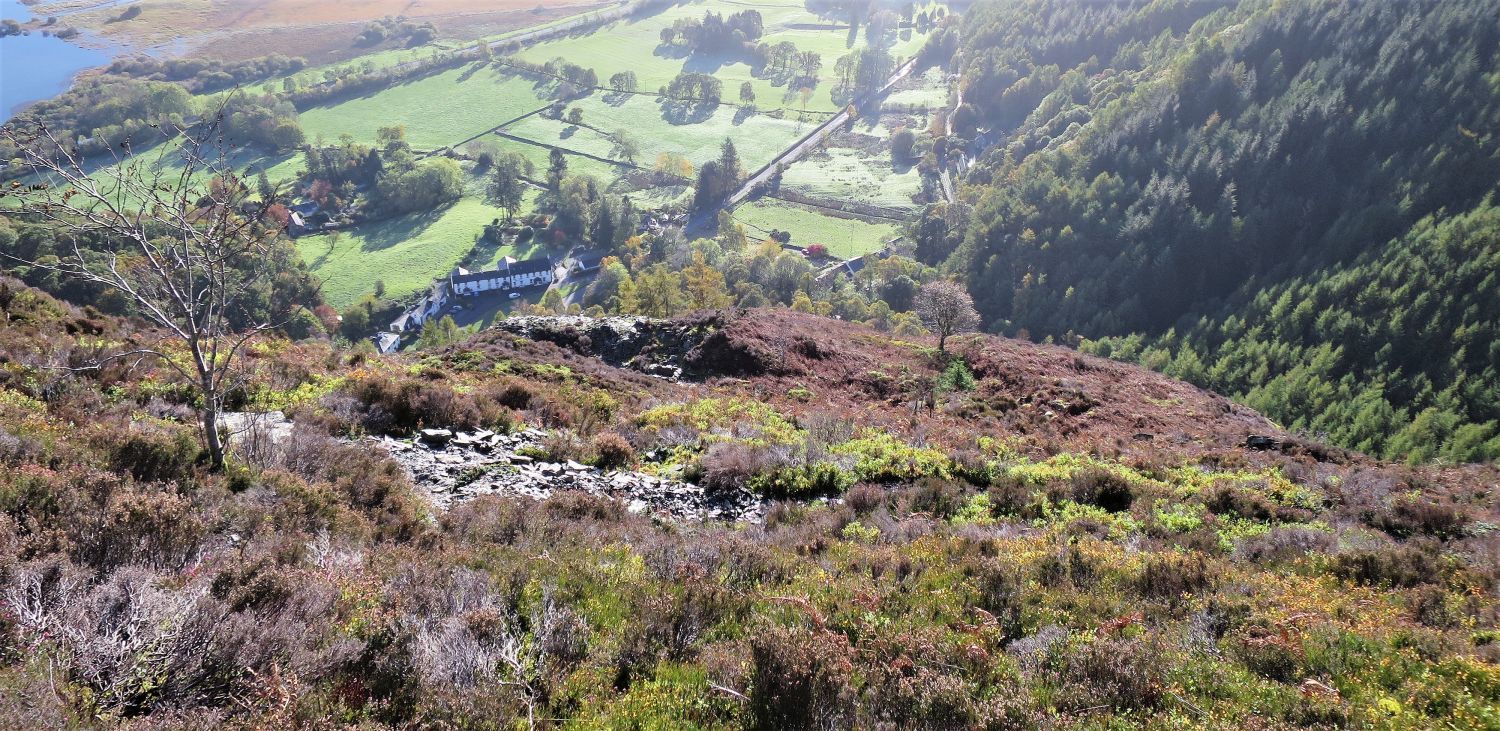 Looking back down the south-east ridge
Looking back down the south-east ridge
We now rejoin Wainwright’s route above the ‘second gully’. Here, the bield and the “solitary rowan” can be seen in the centre of the picture.
 The ‘lower traverse’ and ‘higher traverse’ on Slape Crag
The ‘lower traverse’ and ‘higher traverse’ on Slape Crag
This is a really important photo for anyone wanting to traverse Slape Crag safely.
The small dark vertical cleft towards the bottom left, is the ‘lower traverse’ and is Wainwright’s “rock traverse” above the “oak and rowan”. The heather terrace on the top right, is the ‘higher traverse’ and is a slightly easier route.
 Frankie on the ‘higher traverse’
Frankie on the ‘higher traverse’
At the end of the heather terrace on the ‘higher traverse’, a very narrow cleft on the crag provides a way to the upper reaches; once again, Frankie shows the way. Even though this short scramble is a slightly easier way than the ‘lower traverse’, care should be taken, and like Wainwright’s route, it is not recommended in wet conditions.
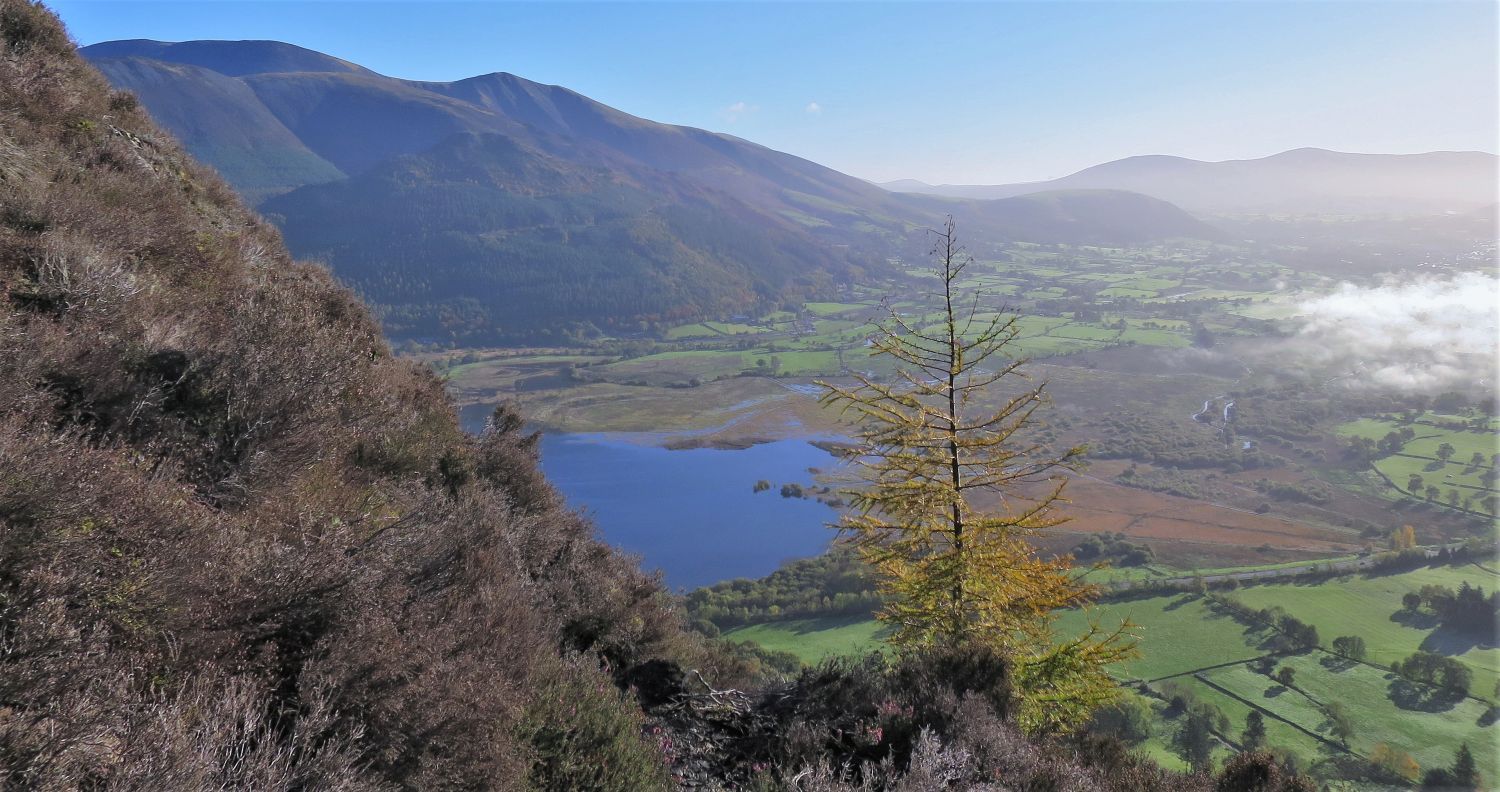 Looking back towards the Vale of Keswick from the exit point of the ‘higher traverse’
Looking back towards the Vale of Keswick from the exit point of the ‘higher traverse’
From the exit point there are two options to reach the “upper escarpment”: In the first edition of the Wainwright guides, Alfred Wainwright advised to: “Ignore” the ‘direct route’, and instead recommends following the ‘pinnacle route’ which traverses below the “upper escarpment”. In the second edition, however, Chris Jesty recommends the ‘direct route’, and the ‘pinnacle route’ has been omitted from page: Barf 6. Both routes are a wonderful way of reaching the “upper escarpment”, and thanks to Clive Hutchby, both will be included in the ‘Walkers Edition’ of the Wainwright guides.
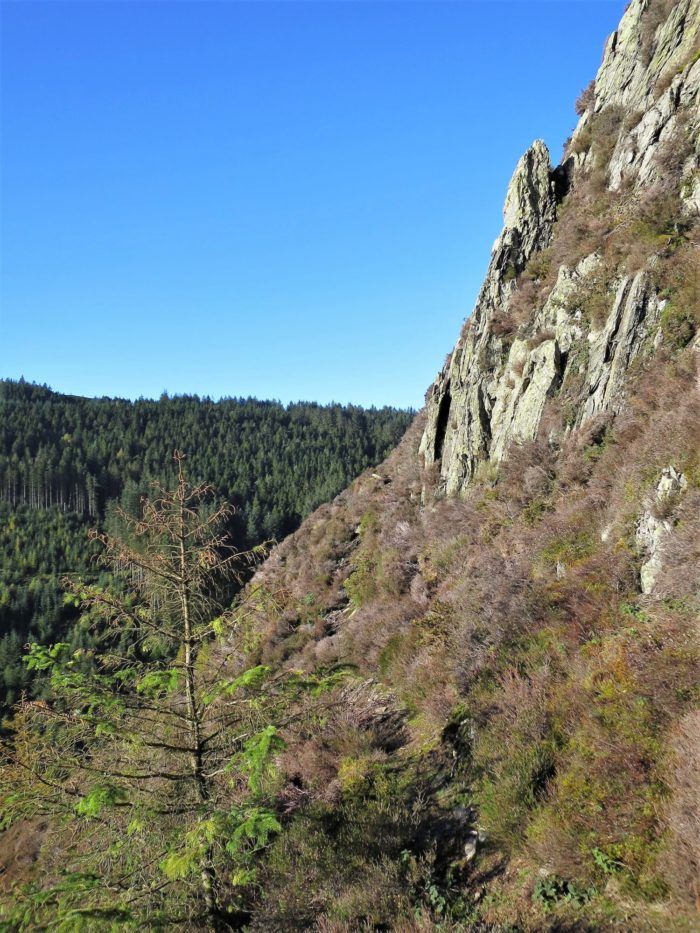 The ‘pinnacle route’ below the “pinnacle”
The ‘pinnacle route’ below the “pinnacle”
Having traversed below the “upper escarpment”, we now arrive at the “pinnacle”; please don’t expect a monumental tower like Napes Needle though, but it’s well worth the visit.
“Round the escarpment on the left, at base of pinnacle” Barf 6
AW
 The path on the “upper escarpment”
The path on the “upper escarpment”
Having passed the “pinnacle”, the path ascends and then takes a sharp right to follow along the top of the “upper escarpment”; this is a wonderful section, and the hard work is over.
“Easier slopes now; difficulties over.” Barf 6
AW
A series of false summits follow now before reaching the summit of Barf.
 Binsey and Bassenthwaite Lake from the ‘rock turret’
Binsey and Bassenthwaite Lake from the ‘rock turret’
Before climbing the “first false summit”, take a little detour to the right where a small ‘rock turret’ provides a great spot to sit and have lunch; this ‘rock turret’ will be included in the ‘Walkers Edition’ of the Wainwright guides.
“First false summit : sudden, dramatic view of Bassenthwaite Lake below” Barf 6
AW
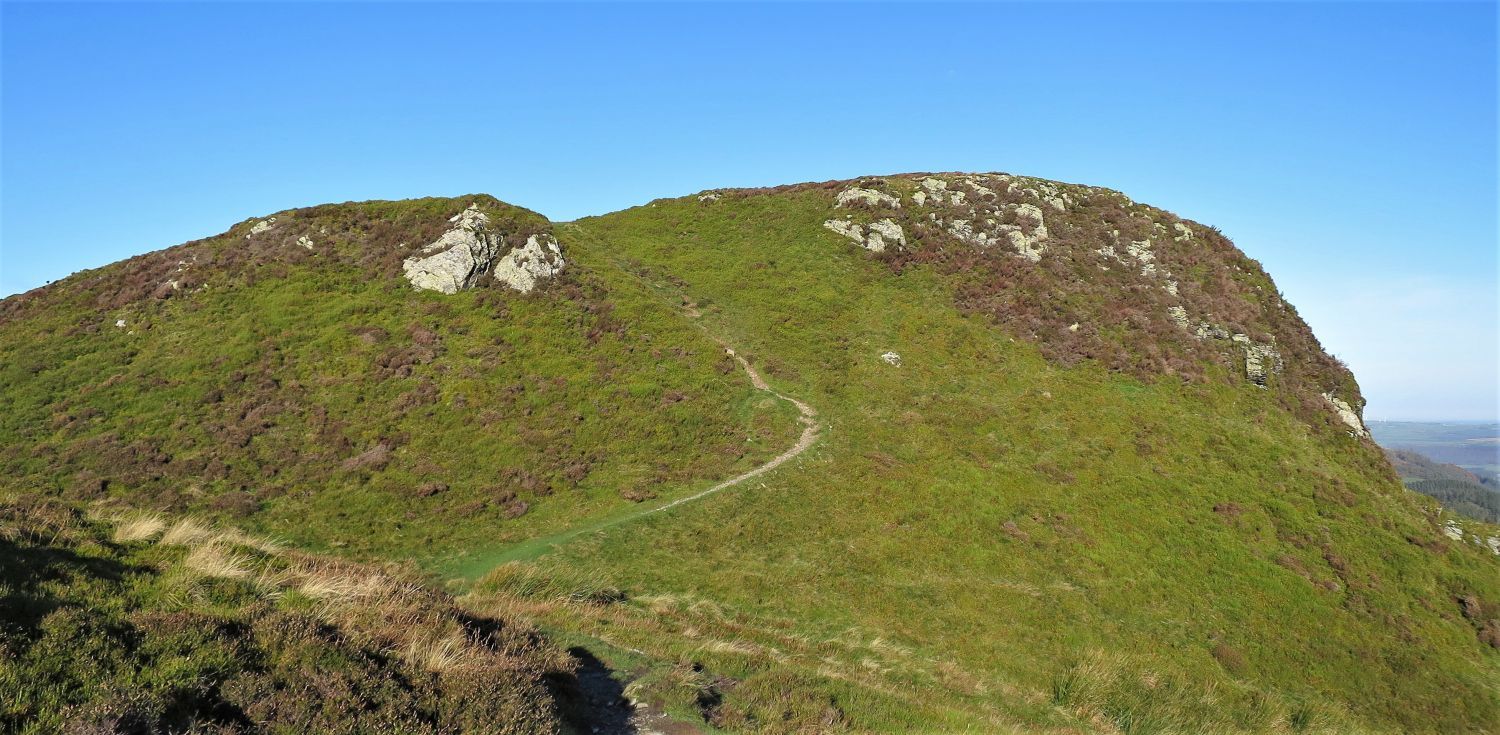 Approaching the “true summit” of Barf
Approaching the “true summit” of Barf
“Second false summit : true summit in view” Barf 6
AW
 The summit plateau of Barf with Skiddaw far right
The summit plateau of Barf with Skiddaw far right
“The summit of Barf is the one place above all others for appreciating the massive build-up of Skiddaw, here seen, at mid-height, piling up from the shore of Bassenthwaite Lake in three great leaps to the summit 1500 feet above the viewpoint…..”
 Binsey and Bassenthwaite Lake from the summit of Barf
Binsey and Bassenthwaite Lake from the summit of Barf
“…..The Lake, too, is exceptionally well displayed directly below – a sensational surprise for those who reach the top from ‘behind’. There is a pleasing view of the Vale of Keswick and Derwentwater and an extensive prospect seawards.” Barf 8
AW
 Lord’s Seat from the summit of Barf
Lord’s Seat from the summit of Barf
“Barf is really a shoulder of Lord’s Seat, which rises beyond but is unseen from the road.” Barf 2
AW
 Ullister Hill from the summit of Barf
Ullister Hill from the summit of Barf
 Frankie on the descent to Beckstones Gill
Frankie on the descent to Beckstones Gill
We now start our descent following a lovely grass ridge down towards Beckstones Gill.
 Lord’s Seat and the head of Beckstones Gill
Lord’s Seat and the head of Beckstones Gill
 Beckstones Plantation from the descent to Beckstones Gill
Beckstones Plantation from the descent to Beckstones Gill
 Looking back towards Barf from Beckstones Gill
Looking back towards Barf from Beckstones Gill
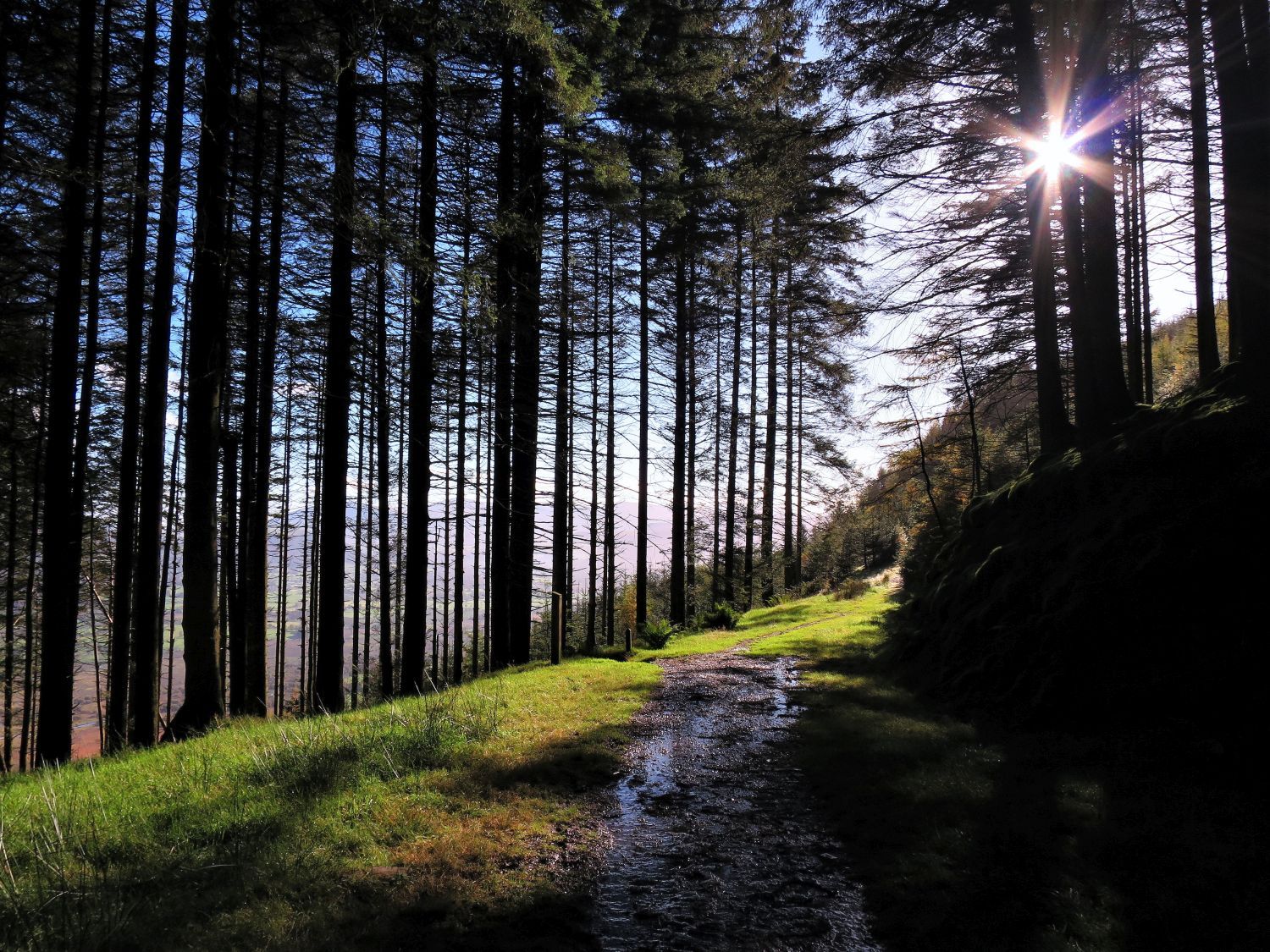 Forest road in Beckstones Plantation
Forest road in Beckstones Plantation
“Blasted out of crags, this road is a considerable engineering achievement.” Barf 4
AW
 Barf from Beckstones Plantation
Barf from Beckstones Plantation
 The descent path down Beckstones Gill
The descent path down Beckstones Gill
This path on the south bank of Beckstones Gill, which winds its way through the young trees on the edge of Beckstones Plantation, is one of the finest in Lakeland.
 Skiddaw range and the Vale of Keswick, from Beckstones Gill
Skiddaw range and the Vale of Keswick, from Beckstones Gill
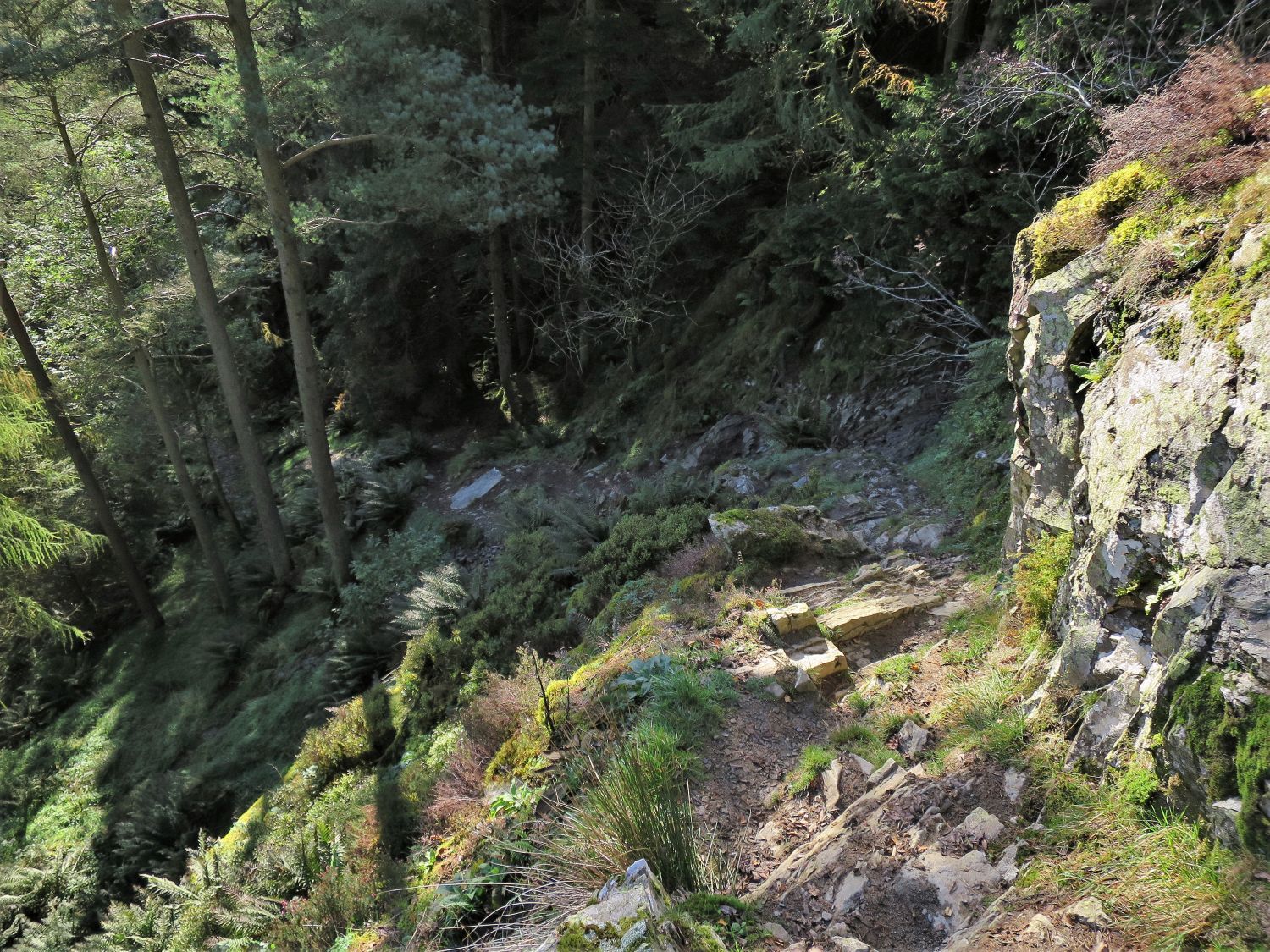 Descent of the “small rockface” in Beckstones Gill
Descent of the “small rockface” in Beckstones Gill
 Looking back at the “small rockface”
Looking back at the “small rockface”
“Here scrambling is necessary at a small rockface. A post is provided to show the way, but the route is in no real doubt.” Barf 4
AW (updated by CJ)
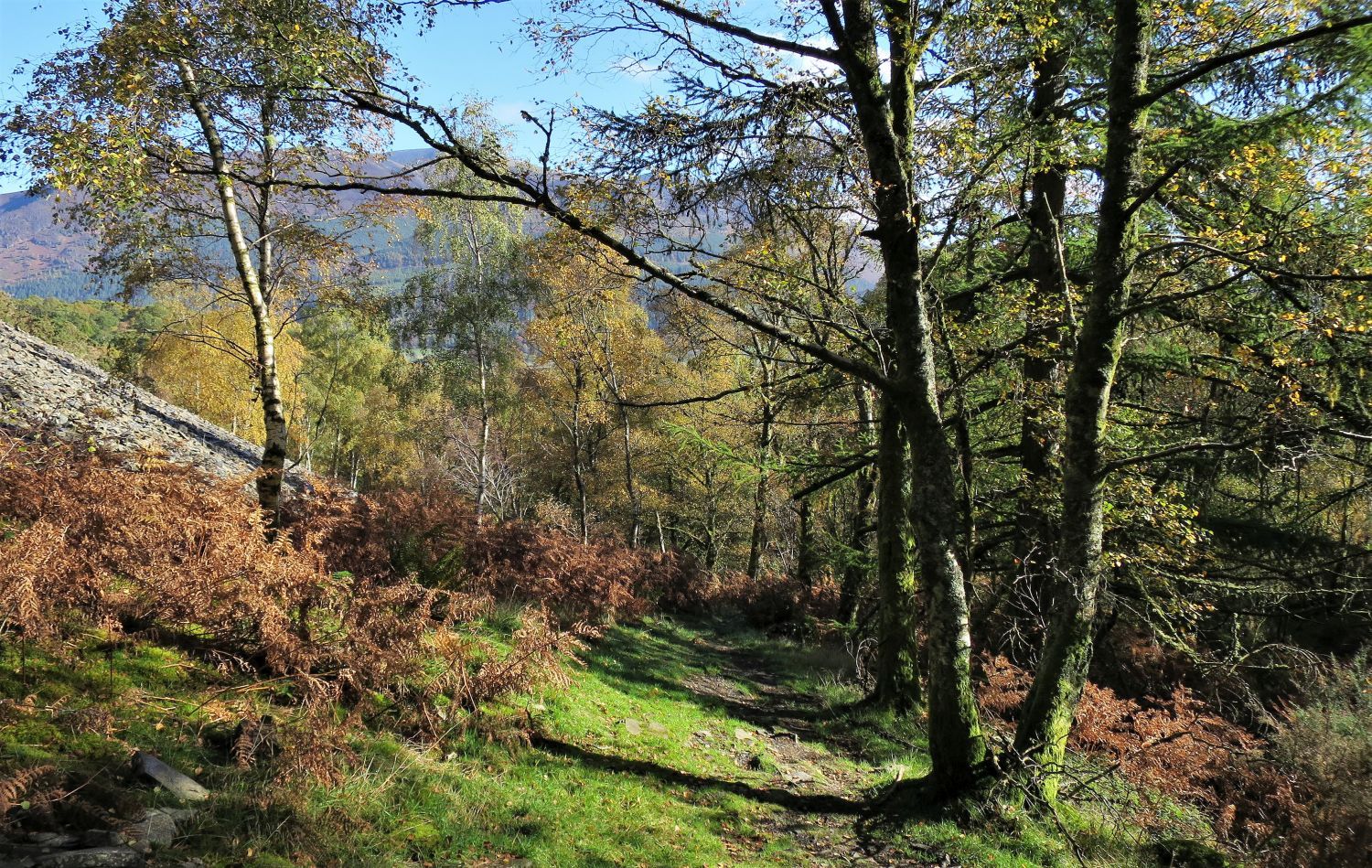 Back to the base of the south-east ridge of Barf
Back to the base of the south-east ridge of Barf
 Interesting fungi on a tree at Powter How
Interesting fungi on a tree at Powter How
Thank you for visiting.
Richard Jennings

